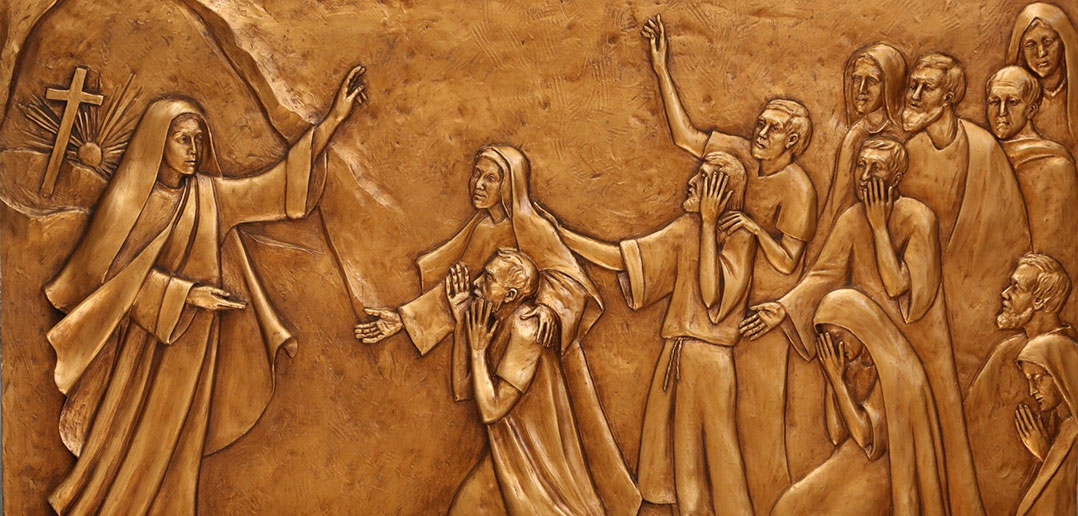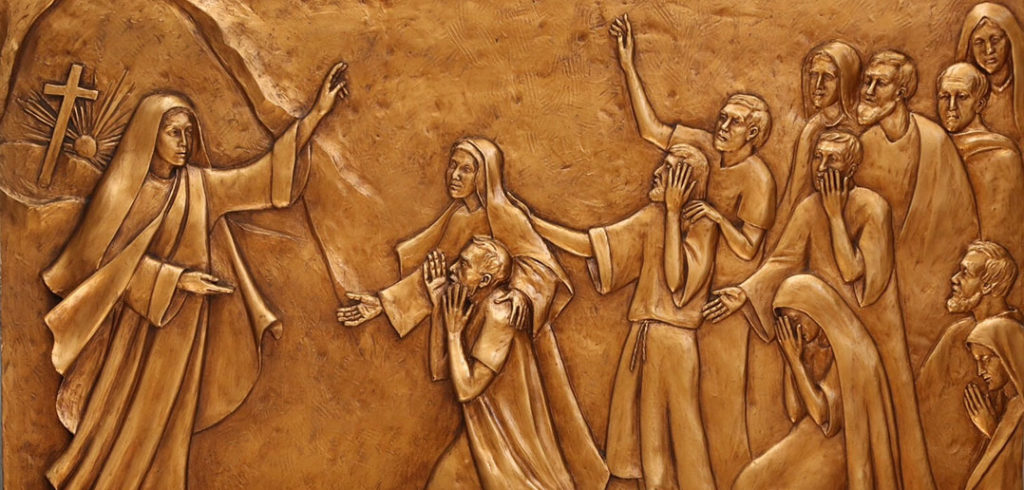Saints and Ironies

I used to discount the stories of the saints in my Roman Catholic upbringing, but a couple of times this week I am reminded that they are not only our inheritance.
New Yorker writer Rebecca Mead pulled out an image this week to write about the March for Our Lives.The silent, head-shaven Emma Gonzalez reminded her of the classic 1928 film about Joan of Arc, and others had made the comparison to the saint as well. But here’s the irony: Joan of Arc waged war for her country and Emma Gonzalez wants to make war not possible on our streets and in our schools. Joan heard the voices of saints; Emma hears the cries of those who died around her. Mead concludes:
In the iconography of “The Passion of Joan of Arc,” Joan has authority not because she is wise but because she is innocent. She has the privileged knowledge of the inspired, not the earned knowledge of the experienced. The young people of Marjory Stoneman Douglas High School have already experienced more than their elders would wish upon them; their innocence is lost. Yet, like all young people, they’ve retained faith in their generation’s unique ability to challenge and rectify the failures of their elders. “Maybe the adults have gotten used to saying, ‘It is what it is,’ but if us students have learned anything, it’s that if you don’t study you will fail. And in this case, if you actively do nothing, people continually end up dead, so it’s time to start doing something,” González said in her speech in Fort Lauderdale, in February. “We’re going to be the kids you read about in textbooks.”
EJ. Dionne wrote about the people Gonzalez was probably thinking of in one of his columns this week: “In 1960, the nation’s attention was captured by young civil rights activists who sat in to integrate lunch counters in Greensboro, North Carolina.” He and others this week have described the civil rights movement as led by young people. I participated in that movement as a college student in1964, but I don’t think I considered it a youth-led movement. I so revered national leaders like Martin Luther King Jr. and Ella Baker that I failed to interpret the energy that the profound, on-the-ground leadership of people like Bob Moses and Anne Moody, John Lewis and Diane Nash gave to it. My particular venture to register voters in 1964 Louisiana was led by Jane Duffin; she was older than I was, but actually, not much older. To me then, civil rights was a movement of people of all generations to right a historic wrong. But the energy – youthful.
The movement against the Vietnam war had that same energy. Cynics say that the peace movement was driven by an ever-widening draft. Young men feared for their lives. The students today articulate that same terror through their signs and speeches all over the country. Dionne says, “These marches finally established guns as a voting issue for those who (as the signs carried by demonstrators declared in various ways) place the desire to save innocent lives ahead of preserving unlimited access to weapons.” But then I think, there are so many issues in this country right now to vote on; why this one? The energy of the young. The threat to their lives, not only in the schools, churches, movie theaters of the affluent but in the streets and the neighborhoods of young people of color, especially. The young leaders understand their privilege and involve those who suffer more gun violence, more frequently, more fatally. “Vote them out” has a chance of succeeding – with their energy.
This movement happens to coincide with the preliminary meeting of about 300 selected Catholic youth from around the world to prepare for the October “Synod on Young People, the Faith, and Vocational Discernment.” In NCR Tom Reese summarizes the document they came up with, a call for an authentic, empowering church. Joan of Arc, Emma Gonzalez. Even Pope Francis asks young people not to keep quiet: Cry out! Will he, and the Bishops who will actually participate in the synod, get what the young people need?
We have gone through the Holy Week emotional roller-coaster: hosanna on Palm Sunday, communion and humble service on Holy Thursday, profound grief on Good Friday, and now, Holy Saturday, waiting for Easter. To conclude, I will turn to a saint of multiple images, Mary Magdalene, who probably did not know she was waiting for Easter on her Holy Saturday. In LaCroix, Nicolaus Seneze interviews Lucetta Scaraffia, identified as “a feminist historian as well as coordinator to L’Osservatore Romano women’s supplement.” I will refrain from reflecting on what it means to be a “supplement” in the Vatican newspaper to say that the interview reports accurately the understanding of Mary Magdalene as “Apostle to the Apostles” and the history behind the images reflected in art and legend of her as a prostitute. For more, see FutureChurch.

St. Mary of Magdala, Apostle to the Apsotles, proclaims the Resurrection
There is a new film that’s been released in England but not here – because of the failure of the Harvey Weinstein firm. That’s the irony. The #MeToo movement takes another casualty, this time a retelling of the Mary Magdalene story, not as a sinner this time, from what I can tell in the trailer. Flora Carr in Time writes: “At the heart of the controversy is the idea that Mary Magdalene’s connection to Jesus was spiritual rather than romantic. For example, in the film’s version of the Last Supper, Mary Magdalene is seated on Jesus’ right-hand side” not because she is Jesus’ wife but because she is to be the leader and his successor, “taking the prized position above any of the twelve male apostles.” Something for us to ponder as we wait for Easter – and the film.


4 Responses
After the resurrection of Christ, religious patriarchy is obsolete. It has been obsolete for 2000 years.
What matters is FLESH, human flesh, not masculinity. For the redemption, and the sacramental economy, the masculinity of Jesus is as incidental as the color of his eyes. Same applies to apostolic succession.
Now that the patriarchal culture is irreversibly passing away, the church can renew her apostolic energy by the ordination of women to the priesthood and the episcopate. This would be in perfect continuity with apostolic tradition, for the faith is always the same yet the source of ever new light.
“Mary Magdalene, apostola apostolorum, pray for us.”
“Mary of Nazareth, mater eucharistia, pray for us.”
http://pelicanweb.org/CCC.TOB.html#CHRONOLOGY
Great rationale. Don’t give up your hopes and dreams. They are bestowed on you from the Lord.
Well put! Let’s keep spreading the message!
Excellent – thank you